

Ronald A. Bergman, Ph.D., Adel K. Afifi, M.D., Paul M. Heidger,
Jr., Ph.D.
Peer Review Status: Externally Peer Reviewed

Human, 10% formalin, H. & E., 162 x.
While most sweat glands are of the merocrine or eccrine variety (i.e., they do not lose cytoplasmic components in any appreciable amount during the secretory process), a specialized variety of sweat gland in the axilla has been considered by some investigators to be of the apocrine variety, in which the apices of the gland cells apparently break off and are lost with the secretory product. These sweat glands are characterized by their large size and large lumen and are less coiled than ordinary sweat glands (see Plate 139).
The epithelial lining is columnar or high cuboidal and varies with secretory activity. Nuclei stain deeply, and lumina are wide. Collagenous connective tissue separates individual glands and ducts.
The apocrine glands are found in the axillary and pubic regions of the body and begin their functional activity at puberty. The secretory product is rich in organic matter, which, when, acted upon by bacteria, produces an objectionable odor. The apocrine glands are activated by adrenergic nerves, and the secretion of these glands can be increased by emotional stress. The secretory activity of the adrenal medulla plays a role in this increased secretion.
Recent phase and electron microscopic studies have questioned the apocrine mechanism of secretion by the axillary sweat glands.
Next Page | Previous Page | Section Top | Title Page
Please send us comments by filling out our Comment Form.
All contents copyright © 1995-2025 the Author(s) and Michael P. D'Alessandro, M.D. All rights reserved.
"Anatomy Atlases", the Anatomy Atlases logo, and "A digital library of anatomy information" are all Trademarks of Michael P. D'Alessandro, M.D.
Anatomy Atlases is funded in whole by Michael P. D'Alessandro, M.D. Advertising is not accepted.
Your personal information remains confidential and is not sold, leased, or given to any third party be they reliable or not.
The information contained in Anatomy Atlases is not a substitute for the medical care and advice of your physician. There may be variations in treatment that your physician may recommend based on individual facts and circumstances.
URL: http://www.anatomyatlases.org/